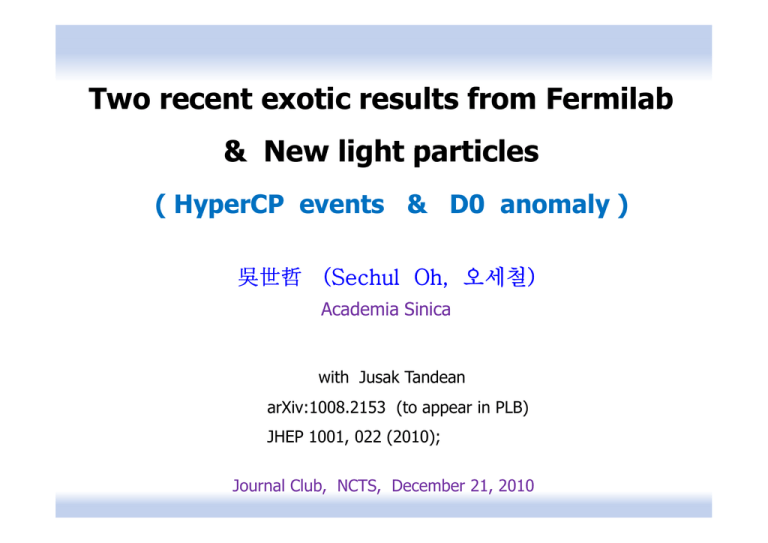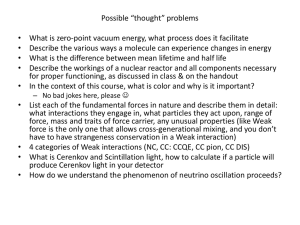Two recent exotic results from Fermilab & New light particles
advertisement

Two recent exotic results from Fermilab & New light particles ( HyperCP events & D0 anomaly ) 吳世哲 (Sechul (S h l Oh, Oh 오세철) Academia Sinica with Jusak Tandean arXiv:1008.2153 (to appear in PLB) JHEP 1001, 022 (2010); Journal Club, NCTS, December 21, 2010 Outline The HyperCP events E pe iments HyperCP Experiments: H pe CP (Fermilab) (Fe milab) , KTeV (Fermilab) (Fe milab) , Belle (KEK) data Theoretical interpretations: a new light particle Implications to B decay processes Th D0 anomalous l lik i dimuon di h t The like-sign charge asymmetry Experimental data from D0 (Fermilab) Theory: a model-independent approach with a light spin-1 particle Sechul Oh 2 The HyperCP events Sechul Oh 3 Introduction The detection of a new particle having a sub-GeV mass would likely hint at the presence of physics beyond the SM. This possibility has been raised recently by the observation of three events for the rare decay mode Σ+ Æ p μ+ μ- with dimuon invariant masses narrowly clustered around 214.3 MeV by the HyperCP Collaboration a few years ago. Sechul Oh 4 HyperCP data (Fermilab) Sechul Oh (1/4) 5 HyperCP data (Fermilab) FCNC (2/4) internal conversion SM Sechul Oh 6 Digression: History of β decay n Æ p S. Oh e- (1/3) _ νe Rare B decays with HyperCP particle 7 Digression: History of β decay n Æ p e- _ ν?e (2/3) Î 2 body decay ? ? Continuous energy spectrum S. Oh Rare B decays with HyperCP particle 8 Digression: History of β decay n Æ p e- _ νe (3/3) Î 3 body decay ! Continuous energy spectrum Î 3 body decay S. Oh Rare B decays with HyperCP particle 9 What if an opposite situation happens? ( i.e.,, 3 bodyy decayy ?? Î No,, 2 bodyy decayy !! ) Sechul Oh 10 HyperCP data (Fermilab) (3/4) Æ 3-body decay type 213.7, 214.3, 214.7 MeV/c2 Æ within 1 MeV/c2 !! Sechul Oh 11 HyperCP data (Fermilab) (4/4) The dimuon mass distribution for Σ+ Æ p μ+ μ- decay is expected to be broad (Å 3-body decays). Assuming a “3-body decay,” the probability that the three events have the same dimuon mass (within 1 MeV/c2) is less than 1% !! Î The unexpectedly narrow dimuon mass distribution may suggest a two-body decay: Sechul Oh 12 Possible new particle (X0) interpretations (1/2) In the spinless case, X0 could be g Sgoldstino in SUSY models D.S. Gorbunov and V.A. Rubakov (2006) CP-odd Higgs gg boson in the next-to-minimal SUSY SM (NMSSM) X.G. He,, J. Tandean and G. Valencia ((2007)) In the spin-1 case, one possible candidate for X0 is Gauge (U) boson of an extra U(1) gauge group in some extensions of the SM C.H. Chen, C.Q. Geng, and C.W. Kao (2008); M. Pospelov p ((2008); ); M. Reece and L.T. Wang g (2009) ( ) Sechul Oh 13 Possible new particle (X0) interpretations (2/2) The presence of X0 in Σ+ Æ p μ+ μ- implies that it also contributes to other ||ΔS|| = 1 transitions: K Æ π μ+ μ- . g, e.g., X0 ( Spin 0 case ) s d The “scalar part” of the s-d-X coupling is already constrained by small K Æ π μ μ data to be negligibly small. The “pseudoscalar pseudoscalar part part” of the ss-d-X d X coupling can be probed by K Æ π π μ μ measurements. Î KTeV experiment Sechul Oh 14 KTeV data (Fermilab) arXiv:0911.4516 He, Tandean, Valencia The scenario in which X has spin 0 and its ss-d-X d X pseudoscalar coupling is “real” is disfavored. Î But, the case where the s-d-X s d X psedoscalar coupling is almost “purely imaginary” is still allowed. The scenario in which X has spin 1 is not yet strongly challenged by the KTeV data. Sechul Oh 15 Belle data (KEK) PRL 105, 091801 (2010) This results rule out some of “sgoldstino” scenario. scenario Î The Belle result also restricts the spinless X0 scenario. Sechul Oh 16 Focus on B decays Various B meson decay processes can be used to search for the hypothetical new particle X0. Î B decays become important to probe the X0 . Consider the contributions of X with “spin 1.” C.H. Chen & C.Q. Geng (2007) Adopt a model-independent approach. Our assumptions are Assume that X has both “vector” vector and “axial-vector” axial vector couplings to b-d & b-s. X does not interact strongly and decays inside the detector with Sechul Oh 17 Effective Lagrangian with a Light X0 Assuming that X has spin 1 & does not carry electric or color charge, the Lagrangian describing the effective b-q-X couplings (q = d, s) is Sechul Oh 18 B0 - bar B0 mixing (1/3) It is characterized by the physical mass difference between the heavy and light mass-eigenstates in the b q Sechul Oh X0 (q = d, s) system. q b 19 B0 - bar B0 mixing (2/3) (1) q = d (2) q = s Sechul Oh 20 B0 - bar B0 mixing Sechul Oh (3/3) 21 Inclusive decay b Æ q X X0 b q =d, s Decay rate: Branching ratio: BaBar data: Sechul Oh 22 B Æ P X decays (1/2) X0 B b d, s q q P, S Decay amplitude & rate: the vector coupling only! the axial-vector coupling only! Sechul Oh 23 B Æ P X decays (2/2) Exp. data: most stringent constraints ! Sechul Oh 24 B Æ V X decays X0 B b d s d, q q V, A Belle data: Sechul Oh 25 Combining B Æ PX & V X decays Sechul Oh 26 Our predictions: B Æ P X decays Using gVd bounds: Using gVs bounds: Sechul Oh 27 Our predictions: B Æ V X decays Using gVd & gAd bounds: Using gVs & gAs bounds: Sechul Oh 28 Our predictions: B Æ S X & AX B Æ SX In contrast to the B Æ P X case, case gAq is the only relevant coupling ! B Æ AX In contrast to the B Æ V X case, the gVq term in the longitudinal component H0 is dominant. Sechul Oh 29 Summary The possibility that X has spin 1 is not well challenged by experiment y yet. Various B meson decay processes can be used to search for the hypothetical new particle X0. Î The B Æ M X branching ratios are predicted to reach the 10-7 level, which is comparable to the upper limits (~ 10-8) for o the branching ba g ratios a o of o B Æ ρ0 X,, K*0 X recently measured by Belle. We would like to encourage our experimental colleagues to make more e g at Belle II and LHCb experiments. experiments efforts to search for the X0, e.g., Sechul Oh 30 The D0 anomaly Sechul Oh 31 D0 Anomaly (1/2) X B B q0 B q0 X Sechul Oh 32 D0 Anomaly (2/2) Sechul Oh 33 Partial List of References (appeared in 2010) ~ 70 papers so far Sechul Oh 34 Theory (1/2) Sechul Oh 35 Theory (2/2) Im Experimental values New Physics Re SM predictions Lenz, Nieste; Kubo,, Lenz Sechul Oh 36 Effective Lagrangian with a Light X0 Assuming that X has spin 1 & does not carry electric or color charge, the Lagrangian describing the effective b-q-X couplings (q = d, s) is Sechul Oh 37 B0 - bar B0 mixing: Ms12 (1/3) It is characterized by the physical mass difference between the heavy and light mass-eigenstates in the (q = d, s) system. SM: Sechul Oh 38 B0 - bar B0 mixing: Ms12 X contribution: b X0 q (2/3) q b dominant if mX << mb Sechul Oh 39 B0 - bar B0 mixing: Ms12 Sechul Oh (3/3) 40 B0 - bar B0 mixing: Γs12 (1/3) Sechul Oh 41 B0 - bar B0 mixing: Γs12 (2/3) b b s s X0 Bs s Sechul Oh s If mX < mb , mX can be produced as a “physical particle” ! ( cf. heavy Z’ ) s Bs s b b 42 B0 - bar B0 mixing: Γs12 Sechul Oh (3/3) 43 Theory (1/2) Sechul Oh 44 asls, exp, (ΔΜsexp ΔΓsexp ), Γ(b->sX) m X =0.5 =0 5 GeV Sechul Oh m X =2 GeV m X =4 GeV 45 |Γs12 / Γs12,SM|, sin φs m X =4 GeV Sechul Oh 46 asls, exp, (ΔΜsexp ΔΓsexp ), Γ(b->sX) m X =0.5 GeV Sechul Oh m X =2 GeV m X =4 GeV 47 Summary We have investigated the possibility that the D0 anomaly arises from the contribution of a light spin-1 particle to the Bs mixing. In contrast to a heavy Z’ particle, X can be produced as a physical particle ti l in i Bs decay, d and d so it affects ff t nott only l Ms12 , but b t also l Γs12. Under constraints from available experimental data, the effect of X can increase |Γs12| to become a few times larger than its SM value, and enlarge the size of sinφs by a factor of a few hundred. Î Can explain the D0 anomaly. Î But, mX ~ 0.2 GeV is unlikely allowed. Thank you! Sechul Oh 48








